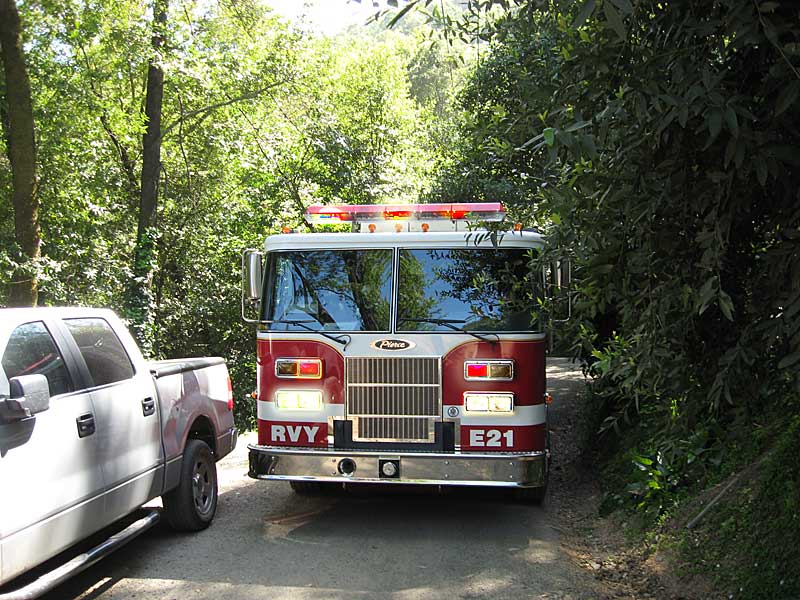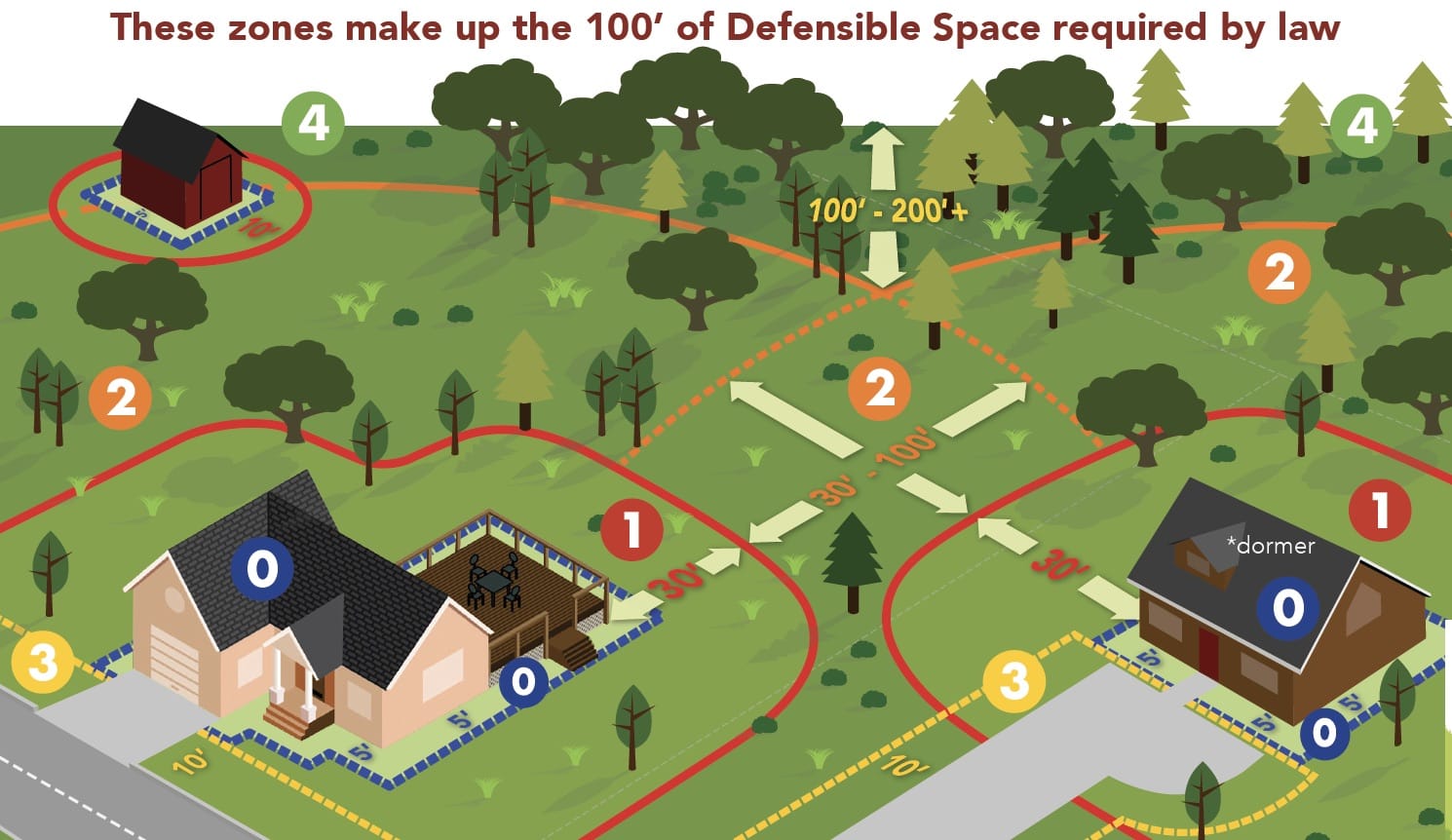Defensible Space
Defensible space is essential to improve your home’s chance of surviving a wildfire. It’s the buffer you create between a building on your property and the grass, trees, shrubs, or any wildland area that surround it.
Defensible space will slow or stop the spread of wildfire and protect your home from catching fire – either from direct flame contact or radiant heat. Defensible space is also important to help protect firefighters when they are defending your home.
Your home may be the most valuable investment you ever make. If you live in a high-risk fire hazard area, protect against the chance of losing that investment by creating defensible space and using fire-resistant construction materials and techniques. Creating an area of defensible space does not mean you need a ring of bare dirt around your home. Through proper planning, you can have both a beautiful landscape and a fire safe home.
To look up residential Defensible Space reports, visit https://dspace.marinwildfire.org
Defensible Space Zones
Three zones make up the required 100 feet of defensible space. Zone Zero extends 0-5' from structures, including the building itself, and should be completely free of combustibles. Zone 1 begins 5' from your house and extends 30 feet away. The most aggressive clearance is required closest to the structure. Zone 2 lies beyond the home defense zone, extending at least 100 feet from the house or to your property line. Greater defense zone widths may be necessary if your home is on a steep slope or in a windswept exposure. The Access Zone, Zone 3, is adjacent to roads and driveways, 14' overhead and 10' from the edge of the roadway. Specific recommendations for each zone are described below.
ZONE 0 ("ZERO")
0'-5'
Zone Zero, sometimes referred to as the "Immediate Zone" is the area nearest your house, 0'-5', including the surfaces of the structure itself. There should be ZERO combustibles in this zone!
This zone extends 0'-5' from your house. It's the area closest to your house, including plants, decks, outdoor furniture, and the outside walls and coverings. This area is most vulnerable and should be more aggressively maintained for fire resistance.
- Remove combustible outdoor furniture. Replace with metal or non-combustible varieties.
- Replace jute or natural fiber doormats with heavy rubber or metal grates.
- Remove or relocate all combustible materials including garbage and recycling containers, lumber, trash, and patio accessories.
- Clean all fallen leaves and needles.
- No vegetation is recommended within 5’ of any structure.
- Remove tree limbs that extend into this zone. Fire prone tree varieties should be removed if they extend into this zone.
- Do not store firewood, lumber, or combustibles here, even (especially) under decks or overhangs. Move stored combustibles inside or at least 30’ from any structure.
- Use only inorganic, non-combustible mulches such as stone or gravel.
- Hardscaping is strongly recommended around the base of structures.
ZONE 1
5'-30'
Zone 1, sometimes referred to as the "home Ignition Zone" extends from your house's exterior walls to a distance of 30'. The "Lean, Clean, and Green" zone.
This extends 0'-30' out from buildings, structures, decks, etc, and overlaps the Home Ignition Zone described above.
- Remove all dead grasses, weeds, plants, & foliage.
- Remove all fallen leaves, needles, twigs, bark, cones, and small branches.
- Remove “Gorilla Hair” or shredded bark mulch.
- Use only compost or heavy bark mulch to maintain soil moisture, or for erosion control.
- Choose only fire resistant plants, and keep them healthy and well irrigated.
- Remove fire-prone plants.
- Provide spacing between shrubs, at least 2 times the height of the mature plant. Add space on steeper slopes.
- Trim trees to remove limbs 6’ to 10’ from the ground.
- Remove branches that overhang your roof or within 10’ of chimneys.
- Move firewood & lumber out of Zone 1, or cover in a fire resistant enclosure.
- Remove combustibles around and under decks and awnings.
- Clear vegetation around fences, sheds, outdoor furniture, play structures.
- Outbuildings and LPG storage tanks should have at least 10’ of clearance.
- Maintain regularly, focusing on the areas closest to structures.
ZONE 2
30'-100'
Zone 2 extends from 30' to at least 100' - more Defensible Space may be required based on topography, vegetation, or building construction (for example, if you live on a hill, in a drainage, or an area surrounded by unusually dense or flammable vegetation, or have a wood shake roof, as much as 150' may be required). California and local laws do not require you to create Defensible Space on property you don't own. Work with your neighbor to gain permission to clear defensible space on their property if it will help protect your home!
Extending from 30'-100' or to your property line at a minimum (you may be required to provide more clearance due to steep slopes, nearby vegetation conditions, and/or other conditions identified by the fire department). This zone should include at a minimum:
- Cut or mow annual grass down to a maximum height of 4 inches.
- Create horizontal spacing between shrubs and trees. (See diagram)
- Create vertical spacing between grass, shrubs and trees. (See diagram)
- Remove fallen leaves, needles, twigs, bark, cones, and small branches. However, they may be permitted to a depth of 3 inches if erosion control is an issue.
- Remove all piles of dead vegetation.
ZONE 3 ("ACCESS")
0'-10', horizontally, and 14' vertically, from roads and driveways
Zone 3, the "access" zone, extends from 3' to at least 10' horizontally form the edge of roads and driveways, and 14' overhead.
Property owners are responsible for vegetation adjacent to roads and driveways. Access roads are critical for evacuation and first responder access. Maintenance is required year-round.
- Property owners are responsible for vegetation adjacent to roads and driveways.
- Clear vegetation 14’ overhead and 10’ from sides of roads and driveways in the same manner as Defensible Space Zone 1.
- Maintain 12’ of unobstructed pavement for passage of vehicles.
- Within this zone, plantings shall be fire resistant and must not extend into the roadway.
- 14’ of clearance is required above the roadway for emergency vehicle access.
- Address numbers must be clearly visible from the road, with at least 4” numbers on a contrasting background. Reflective or lighted numbers are best.
- Create vertical spacing between shrubs, and lower tree limbs. Cut all grasses.
ZONE 4 ("COMMUNITY")
100'-200'+
Work with your neighbors
Many homes do not have 100’ of space between structures and parcel lines. Property owners are required to maintain defensible space to their property line. Work with neighbors to help provide defensible space for their homes, and ask neighbors for help if their property threatens yours. In most cases, the most effective solution is a cooperative approach between neighbors.
Remember that the most important zone is closest to your structures - from zero to five feet. If you’ve taken all of the steps outlined here and worked to “harden” your home, neighboring properties typically present only a minimal risk.
Work with neighbors or land managers to reduce fuel on nearby properties or create fuel breaks to help reduce the risk to your community. Contact Ross Valley Fire Department for help organizing your neighbors to create a Firewise USA© site.
Defensible Space and Wildfire Resources:
FIRESafe MARIN
A local non-profit organization dedicated to reducing wildland fires. A good resource for finding Marin-specific conditions and recommendations.
Report a Fire Hazard Online
Ross Valley Fire Department provides residents with a convenient way to report potentially hazardous conditions.
The Importance of Roadway Clearance
 Ross Valley Fire Department operates specialized fire apparatus that helps us navigate the narrow streets and hills of our community. Even with our state-of-the-art fire engines, we depend on roadways clear of obstructions and overgrown vegetation to access your neighborhood safely and quickly during emergencies. Cooperation and involvement from homeowners in each hillside neighborhood is critical to prevent obstructions, like illegally parked cars and overgrown vegetation, that ·impede our access and your safe escape in the event of a wildfire. Your survival during a fast spreading wildfire may depend on vegetation clearance work finished months earlier.
Ross Valley Fire Department operates specialized fire apparatus that helps us navigate the narrow streets and hills of our community. Even with our state-of-the-art fire engines, we depend on roadways clear of obstructions and overgrown vegetation to access your neighborhood safely and quickly during emergencies. Cooperation and involvement from homeowners in each hillside neighborhood is critical to prevent obstructions, like illegally parked cars and overgrown vegetation, that ·impede our access and your safe escape in the event of a wildfire. Your survival during a fast spreading wildfire may depend on vegetation clearance work finished months earlier.
